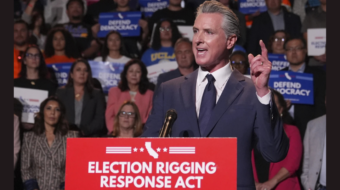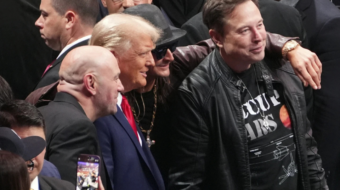CHICAGO (PAI)–Imagine mobilizing one of every 100 Americans, a population equal to that of the entire city of Chicago, and putting them out on the campaign trail. That’s what Barack Obama’s presidential campaign seeks to do. In talks August 5 to the AFL-CIO Executive Council meeting in Chicago, Obama’s top two staffers, strategist David Axelrod and manager David Plouffe, set that as their goal for nationwide mobilization. They now have 1.2 million volunteers.
“We were impressed,” AFL-CIO President John J. Sweeney said in an exclusive interview with Press Associates Union News Service and with the Bureau of National Affairs after the meeting closed. Politics, as might be expected, dominated the meeting.
Axelrod and Plouffe, joined by Obama himself on a videoconference to the council that day, again pushed for labor’s wholehearted support for the presumed Democratic presidential nominee in this fall’s election.
“I need labor’s mobilization to win,” Obama told the union leaders. They did not seek a numerical “pledges or commitments,” Sweeney said. Nevertheless, he added, the AFL-CIO and the Obama campaign are already talking about specific geographic areas” where we may be able to help in volunteers,” the AFL-CIO president added.
“We’ll discuss in which cities they need our people the most,” Sweeney said. “The program we outlined is what we’ll discuss with the Obama people,” he added. That program, federation Political Director Karen Ackerman has said in the past, includes hundreds of thousands of volunteers, millions of worksite visits and flyers, and at least $54 million in get-out-the-vote and educational spending.
In the August 6 interview, ranging over the content of the 2-day meeting in Chicago, Sweeney said he was most impressed with “how active our affiliates”–its member unions–“are, in so many different ways,” not just politically. Other activism he mentioned included:
New organizing drives, particularly by the American Federation of Teachers Texas, by the Steel Workers among car wash workers in Los Angeles and–though the Auto Workers did not come to Chicago–the UAW among Atlantic City casino workers.
Sweeney also noted that Dennis Van Roekel, who will take office Sept. 1 as president of the National Education Association, challenged the executive council on August 6 on organizing. The independent NEA, with 3.2 million members, is the nation’s largest union. In some states, including Minnesota and New York, NEA and the American Federation of Teachers have a joint affiliate.
“His main focus is for us to consider change, to look at new models for organ-izing, and that we don’t have workers in the same sectors we had, like manufacturing,” Sweeney said. Van Roekel admitted “it took some working at it to accept change and to in the right directions to go” in organizing. Sweeney said he has the impression, from this meeting, that AFL-CIO member unions are moving in that direction, too.
* The growth of Working America, the federation’s affiliate for people who lack opportunity to formally organize into a local union and collectively bargain. The group,, founded in 2003, has 2.5 million members and another 1.5 million relatives, he said.
Working America members, who pay nominal yearly dues, agree with the federation on various issues, but need a vehicle to express them, Sweeney said. There is little difference, Working America canvassers noted, “between the members they sign up and the union member next door.”
“They realized they had to be part of a movement to address issues” affecting the middle class, Sweeney said of Working America’s millions. “They’re just not at the point of achieving collective bargaining.”
Continuing cooperation with both NEA and Change to Win on politics, primarily through the Solidarity Charter program–which has been extended through the AFL-CIO convention in November 2009–with CTW member unions and the Labor Solidarity Partnership program with NEA locals. The NEA partnerships let those locals participate in AFL-CIO affairs as if they were directly affiliated local unions, not members of an international union.
“Some of the Change to Win unions are fully engaged,” in the AFL-CIO’s political program, Sweeney said, singling out the Laborers, who rejoined the federation’s Building Trades Department earlier this year. Other CTW affiliates “are partially engaged,” Sweeney added. There are more than 3,000 Solidarity charters for locals of the seen CTW unions: The Laborers, Teamsters, the United Food and Commercial Workers, UNITE HERE, Carpenters, Farm Workers and Service Employees.
But an AFL-CIO council statement, approved in its closing hours, indicated that not all may be sweetness and light in the Solidarity Charters program. It said if a CTW member local “raids” an AFL-CIO local–or dumps its charter before launching a raid–the AFL-CIO may be forced to retaliate by yanking the charters from other locals in the raiding local’s union. Sweeney specifically cited a nasty confrontation this year between the AFL-CIO member California Nurses Association, and SEIU in Ohio.
All of this, however, is against the backdrop of the presidential election. “We’re mindful we have to do our damnedest to elect Barack Obama,” Sweeney said.









